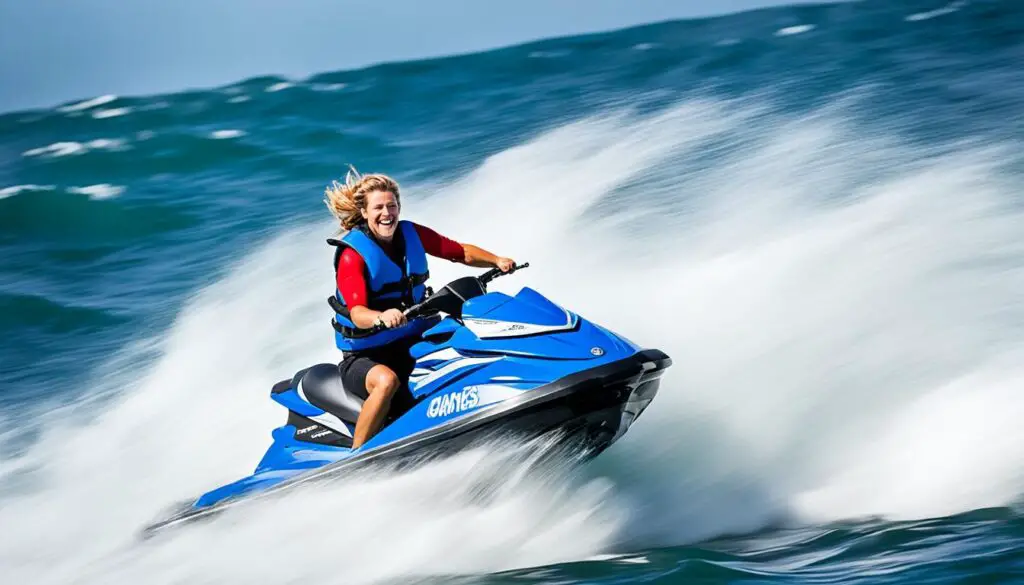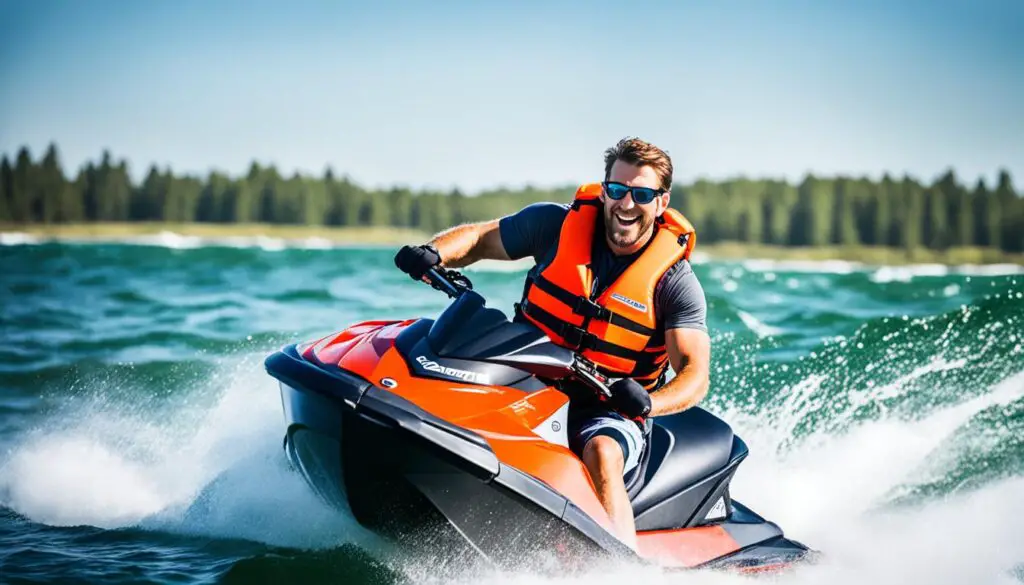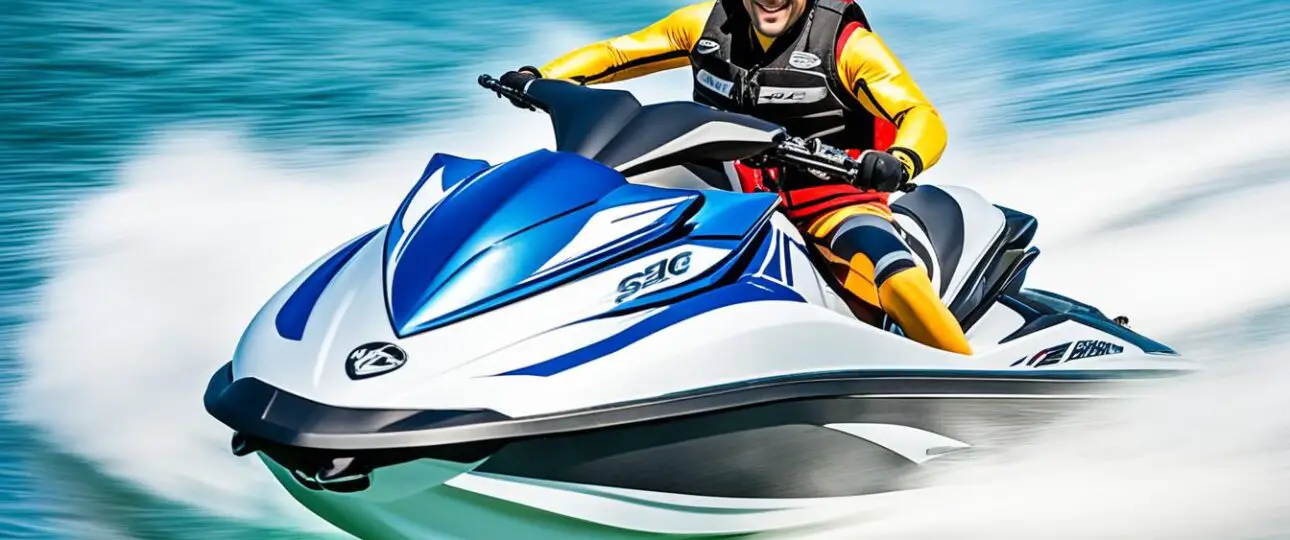If you’re reading this, chances are you’re eager to make your dream of riding a jet ski a reality. Our team, fueled by a deep passion for water sports, is committed to introducing beginners to the exhilarating world of jet skiing. Jet skis, often synonymous with exhilaration and freedom on the water, are personal watercraft (PWC) designed for speed and agility. They offer an intimate interaction with the water, allowing riders to feel every wave and turn. Beginners often encounter two main styles of jet skis: stand-up and sit-down models. Stand-up models require good balance and physical fitness, while sit-down models are easier to handle and provide better stability. Before getting on a jet ski, it’s important to know the basic steps such as knowing your boat, finding your comfortable position, understanding hand and feet placement, and igniting the engine.
Key Takeaways:
- Jet skis are personal watercraft designed for speed and agility.
- There are two main styles of jet skis: stand-up and sit-down models.
- Before getting on a jet ski, know the basic steps and safety precautions.
- Stand-up models require good balance and physical fitness.
- Sit-down models are easier to handle and provide better stability.
Step-by-Step Guide for First-Time Riders
To ensure a smooth and safe ride on a jet ski, it’s essential for first-time riders to follow these step-by-step instructions. Start by taking a boating safety course to familiarize yourself with jet ski operation and safety rules. Once you’re ready to ride, find a comfortable sitting position on the jet ski and firmly place your hands on the handlebars and your feet in the footrests.
Make sure the kill switch cord is securely fastened around your wrist and connected to the ignition key. This safety feature ensures that the engine will immediately shut off if you fall off the jet ski. It’s a crucial precaution to prevent accidents and keep you safe.
Now it’s time to start the jet ski. Turn on the ignition switch and gradually push the throttle to start moving. It’s important to start slowly and gradually increase your speed as you gain confidence and experience riding the jet ski.
As you navigate on the water, always steer to a safe distance from the shore and other obstacles to avoid collisions. Maintain a consistent speed that feels comfortable for you, allowing you to stay in control of the jet ski at all times.
Understanding turning dynamics is another vital aspect of riding a jet ski. To turn, gently shift your body weight and lean in the direction you want to go. Experiment with different turning techniques to find what works best for you.
For beginners, it’s recommended to avoid standing on the jet ski until you’re more experienced and confident in your balance and control. Focus on mastering the art of riding while in a seated position before attempting more advanced maneuvers.
Now that you’re familiar with the step-by-step guide for first-time riders, you can confidently embark on your jet ski adventure. Remember to always prioritize safety and follow jet ski safety rules to ensure an enjoyable and worry-free experience on the water.
Differences Between WaveRunners and Traditional Jet Skis
For beginners, WaveRunners present an excellent option for enjoying the waterways with ease and comfort. WaveRunners are personal watercraft manufactured by Yamaha and are known for their stability and user-friendly controls. They are typically sit-down models and offer a more relaxed and comfortable ride compared to stand-up jet skis.
WaveRunners come with a range of features, including innovative hull designs and advanced control systems. They can be used for a variety of activities, making them versatile and appealing to recreational riders.
To better understand the differences between WaveRunners and traditional jet skis, let’s take a closer look at the key features:
| Features | WaveRunners | Traditional Jet Skis |
|---|---|---|
| Style | Sit-down models | Both stand-up and sit-down models |
| Stability | High stability | Varies based on model |
| Ride comfort | Relaxed and comfortable | Depends on the model and rider’s skill |
| Control systems | Advanced control systems | Varies based on the model |
| Activities | Versatile and suitable for various activities | Varies based on the model and rider’s skill |
WaveRunners offer stability and user-friendly controls, making them ideal for beginners who want to enjoy a more relaxed and comfortable ride. Their advanced control systems ensure a smooth and responsive experience on the water.

Key Safety Aspects to Consider
Safety is paramount in the world of jet skiing. Whether you’re a beginner or an experienced rider, it’s crucial to prioritize your safety and the safety of others on the water. By following these key safety rules and guidelines, you can ensure a safe and enjoyable jet ski experience:
1. Life Jacket and Safety Equipment
Always wear a Coast Guard-approved life jacket when operating a jet ski. A life jacket provides essential buoyancy and can save your life in case of an accident or emergency. Additionally, carry necessary safety equipment such as visual distress signals and sound-producing devices for effective communication in challenging situations.
2. Swim and Supervised Areas
While jet skiing is an exciting water sport, non-swimmers can still participate as long as they wear a life jacket and remain in calmer, supervised areas. These areas ensure your safety by restricting access to high-traffic or dangerous spots, allowing you to enjoy your ride with peace of mind.
3. Pregnant Women
If you’re pregnant, it’s essential to consult with your healthcare provider before engaging in jet skiing. While jet skiing can be a thrilling experience, it’s crucial to prioritize your well-being and follow your healthcare provider’s recommendations to ensure a safe and healthy pregnancy.
4. Age and Certification Requirements
Adhere to age and certification requirements set by local boating authorities or governing bodies when operating a jet ski. It’s important to be knowledgeable about legal requirements to ensure that you are qualified and capable of safely operating a personal watercraft.
5. Adherence to Boating Laws and Regulations
Comply with all applicable boating laws and regulations in your area. Familiarize yourself with speed limits, no-wake zones, and navigation rules to ensure the safety of yourself and others on the water. Respect the environment and avoid disturbing wildlife or sensitive habitats.
6. Weather Conditions
Always check weather conditions before heading out on your jet ski adventure. Avoid riding in inclement weather such as storms, strong winds, or heavy rain, which can pose significant risks and impair your ability to safely operate the jet ski.
7. Stay Hydrated
Staying hydrated is essential while engaging in physical activities like jet skiing. Remember to drink plenty of water to keep your body hydrated and maintain optimal performance. Dehydration can lead to fatigue, impaired judgment, and increased risk of accidents.

| Jet Ski Safety Rules | Jet Ski Operation Instructions |
|---|---|
| Wear a Coast Guard-approved life jacket | Pass a boating safety course before operating |
| Carry necessary safety equipment | Find a comfortable sitting position on the jet ski |
| Stick to supervised and calmer areas | Place hands firmly on the handlebars |
| Consult with a healthcare provider if pregnant | Connect the kill switch cord to the ignition key |
| Follow age and certification requirements | Start the jet ski by turning on the ignition switch |
| Comply with boating laws and regulations | Gradually push the throttle to start moving |
| Check weather conditions before riding | Steer to a safe distance from the shore |
| Stay hydrated and drink plenty of water | Maintain a consistent speed and understand turning dynamics |
Enjoy Jet Skiing with Confidence
Jet skiing is an exhilarating and enjoyable water sport that can be enjoyed by beginners with the right knowledge and preparation. Whether you’re a thrill-seeker ready to tackle the waves or someone seeking a leisurely ride on calm waters, driving a jet ski is a fantastic way to experience the freedom of the open water.
By following the step-by-step guide for first-time riders, you can quickly get the hang of driving a jet ski safely and easily. Remember to find your comfortable sitting position, keep a firm grip on the handlebars, and maintain proper control of the throttle. With practice, you’ll be gliding smoothly over the water and confidently making those thrilling turns.
It’s essential to prioritize safety as you embark on your jet skiing adventure. Always wear a Coast Guard-approved life jacket, understand and adhere to all boating laws and regulations, and make sure to carry the necessary safety equipment. By staying mindful of these rules and regulations, you’ll be able to enjoy your jet skiing experience to the fullest.
Whether you choose a traditional jet ski or a WaveRunner for its stability and comfort, the thrill and excitement of jet skiing are unparalleled. So, grab your gear, hit the water, and get ready to feel the wind in your hair as you cruise across the waves. With the right preparation and a commitment to safety, jet skiing will become your new favorite water adventure!



